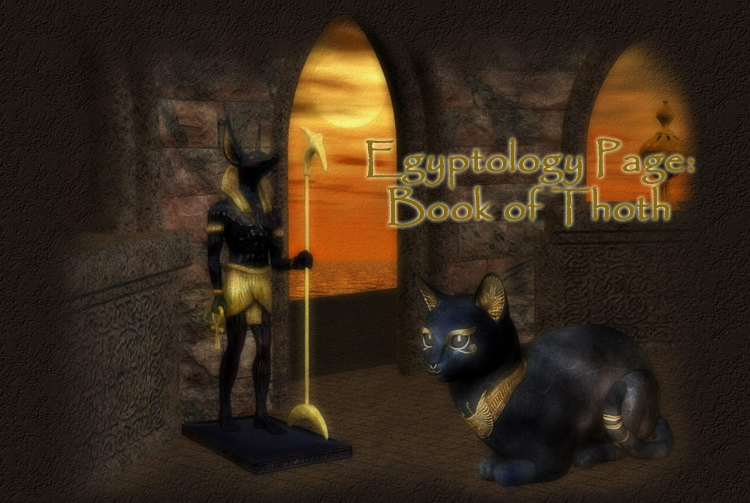The Ancient Egyptian intellectual was not as common as was the Greek or the Hebrew thinker. The Egyptian was mostly concerned with art, architecture, governmental organization, and geometric order (symmetry in hieroglyphic inscriptions, divine proporation in drawing figures, etc); it was in the areas mentioned above that they excelled. This is not to say that the Egyptian was not an intellectual thinker. The examination that follows is comprised of the nature of the universe, the function of the state, and the values of life according to the Ancient Egyptian.
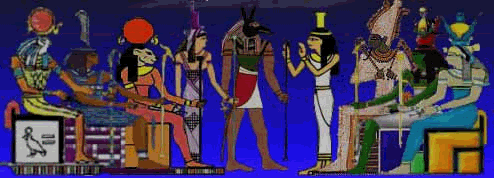
When moderns experience weather, the life cycle of plants, the goings-on in the animal world, or the birth and death of everything, one has a sense of how those things happen. Precipitation is the reason for rainy weather; watering and providing light for plants keep them growing; a squirrel collecting branches, twigs, and other bits of foliage is probably going to make a home in the tallest spot in a tree; most of us know where babies come from and how they are made; and sometimes one knows the cause of death when living things die. One may be able to explain most of the above, if not all, using scientific reason. Since modern science did not exist during pre- and dynastic Egypt, the Egyptians did not approach such things in this way. As far as they were concerned, everything was created, controlled, and manipulated by a vast supply of godly beings. Every natural occurrence, emotion, living thing, and inanimate object had a deity/deities linked to them, which meant that the Egyptians had quite a formidable list of gods and goddesses whom they worshipped. The Ancient Egyptian belief in the existence of gods was not an unmotivated occurrence; what they believed was the result of what they experienced in the world.
As with many religions, both modern and ancient (the latter being that with which we are most concerned), the Ancient Egyptians believed that their world, that the beginning of life was created by gods. The gods themselves were also created by the first gods and the first gods were self-engendered (self-generation was a good enough explanation for the Ancient Egyptian). Depending on where one was—Memphis, Hermopolis Magna, Heliopolis, Elephantine, or elsewhere—the creation story varied; it also depended on which creation story one most preferred. Despite there being many Egyptian creation stories, all of them supported the other, so there is no reason to reject any one of them as being less true (if one rejects one, one must reject them all).
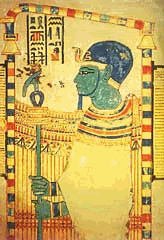
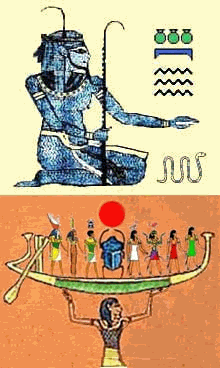
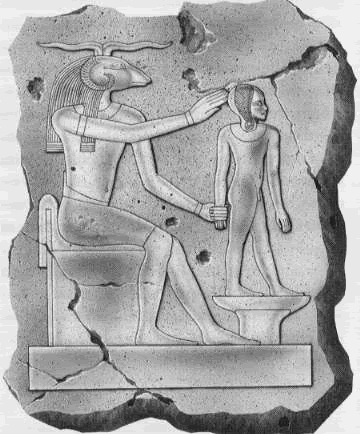
Egyptian mysteries (allegorical as they were) had also a role in the lives of the Ancient Egyptians: not just to entertain, but also to form a true notion of divine nature and to give those involved in the enactments of these stories attainment of fellowship with the divine on earth as well as in the Hereafter. To achieve this much sought-after divine unity, one performed rituals or ceremonies as well as used symbols (objects, amulets), dancing, and singing to animate these mysteries (a.k.a. myths and legends). Granted, Egyptian people played the roles of the gods, rituals provided people with a way to connect physically (more or less) with their gods. Some of these mysteries include the "Murder of Osiris," which was a lamentation for the death of the god of the Underworld; "The Contendings of Horus and Seth," which installed royal traditions; "Isis and the Seven Scorpions," which included not only a noblewoman and her son, but also a peasant girl; and "The Destruction of Mankind," which directly involved the survival of Egyptian civilization. All of the above, in one way or another, created a personal experience between humans and the gods.
Living in a country surrounded by water and desert, the Egyptians had many experiences with natural occurrences and observed many of these occurrences with a keen eye. There were specific gods in charge of regulating the stars, manipulating the Nile, and giving the deserts it's character, for example. In nature and in the universe were coinciding events, which added to the philosophy of the Egyptians and mainly revolved around the theme of rebirth. The best evidence of this theme is the start of the Egyptian new year, which starts when the inundation of the Nile begins. It is also at this time that the Dog Star (called by various names like Sirius, Sothis, or Sopdet) first appears in the night sky, the days after which it disappears for seventy days, a number of time that was also the duration of the mummification process (preparation, preservation, and the burial combined).
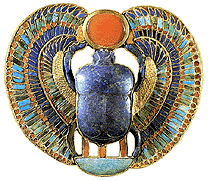
Images are also a-plenty that deal with the theme of rebirth in Ancient Egypt. Khepre (also spelled Kheper, Khepri, or Khepren) was the image that represented this idea. He was the god of the morning son, which, after traveling through the twelve hours of the night in various forms of Ra, was born anew each morning. The scarab beetle that represents Khepre is an appropriate match: the Ancient Egyptians noticed that the scarab beetled rolled up its eggs into a ball of dung. After the gestation cycle terminates, the baby beetles appear to sprout from the ball. Like the real creature, Khepre rolls the young sun into the sky, where Nut gives birth to it. The Egyptians personified the sky like they did the beetle: it was not just an orb around the earth, but also it was a woman (the goddess Nut), a great cow, or a vault that straddled the ground. The ground over which Nut straddled was not just a mass of mud and muck, but also it was her consort, Geb. This god, in the beginning of one creation myth, impregnates her; after this time, Nut produced five gods: Osiris, Horus the Elder, Isis, Nephthys, and Seth (these five deities were the inspiration for the five additional days to the 360-day Egyptian year).
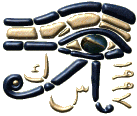
|
Ra and Thoth symbolized the afternoon sun and the moon (astronomical elements representing day and night) respectively. The attachment of each orb to each deity gives one a glimpse of the qualities of Ra (solar) and Thoth (lunar). The wadjet eye (also called the Eye of Ra, the Eye of Horus, and the Eye of Thoth) had also qualities similar to the deity that embodied them. The wadjet, directly linked to Horus, was the left eye that represented healing (Horus’ left eye was healed by the milk of Hathor after Seth tore it out and it was this eye that Horus gave to his father, Osiris, as a symbol of protection). The Eye of Thoth, the right eye, not only had a lunar character, but also it was a symbol of knowledge (Thoth was the patron god of this element as well as of scribes and writing).
|

|
In the Egyptian mind, the universe and everything on earth had a dual purpose. This duality spilled into the function of the state, those who ruled over it, and those who supported those who ruled. For instance, the king was not only a man whose main responsibility was to uphold
ma'at (balance, truth, justice), but also he was a god, the embodiment of Horus the Younger on the throne. The king's godly duty was to commune with the gods and goddesses, appeasing them when he wanted good for his people in times of bad and praising them when Egypt's produce was abound and everyone was happy, peaceful, and productive. Communing with the gods was not just a responsibility, however, it was also an expectation; the people over whom the king ruled and the king's officials expected the king to carry out this duty.
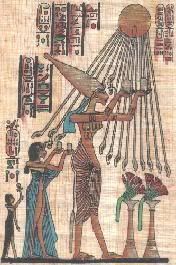
Because the king and the chief god (each city had a chief deity) could not be or have influence everywhere at once, each had advisors, officials, or other high ranking royals who worked for them. In the king's case, he had priestly officials who upheld the laws that the king expected his people to follow and enforced the king's decisions and his word. The best Egyptian myth that illustrates the chief deity and the use of others to do his bidding appears in the story of the Destruction of Mankind. To make a long story short, Ra, having become exhausted with the Egyptians, who were planning to revolt against him, commanded Hathor (in the form of Sekhmet, Hathor's vicious form) to devour them without mercy. Agreeing to carry out the task, Hathor set out on her mission, only half-succeeding: the Egyptians stained beer with red ochre, which caused Hathor (Sekhmet) to drink it up greedily because she thought it was blood. After her alcoholic binge, she became far to drunk to perform her divine task.
With the abundance of the theme of rebirth, one could easily make the mistake of assuming life was the most important thing to the Egyptians (life was important, but it was not the central aspect). Far more relevant to the Egyptians in life was the preparation of death, the readying of one's self for a better life in the Hereafter. It is evident this is so just by viewing the beautiful murals on tomb walls, which show the process of mummification, of travel through the Underworld, of living life peacefully in the Afterlife. Mummification was perhaps the best example of the Egyptians' obsession for a more spectacular life in Paradise: the carefulness taken to prepare a corps took a long seventy days and was executed with great care, with precision, and with good (no, perfect) timing (see Mummification for more information). The philosophy of this obsession was for one to live again forever; the earthly body had to be preserved, every nook and cranny, appendages and entrails. The senses had to be ceremoniously reanimated in order to enjoy smelling, tasting, hearing, seeing, and feeling in the Hereafter as one did on earth, only with more perfection. In other words, the value of living in Egypt was to die and be reborn into Paradise. Unfortunately, not every person had this luxury; only those who could afford it could afford a second, pristine Afterlife.

Directly related to mummification was the Egyptians’ idea of an eternal soul, which they called the
ba. This entity was a spiritual, indestructible, and an eternal being that appeared after death. The Egyptians believed also that this spirit was part of a living person (after death, the
ba separated from the decedent, yet it was still connected with the dead person). In order to keep the
ba eternal, the body of a dead person had to be preserved; the survival of the corpse was directly proportional to the survival of the
ba. Once the body was preserved, the
ba was able to roam free (with the aid of the funeral mask over the mummified person’s head, the
ba was able to return to its original location). In addition, Egyptian artists portrayed the
ba as a bird with a human head--the former half of this depiction supports the Egyptians’ belief in the soaring nature of a person’s soul, which was reflected in the construction of some tombs (from the burial chamber, there was a vertical shaft that led to the outside, in the direction of the sky). However, before the decedent’s soul could fly free, it had to be challenged prior to entering Paradise; a person’s heart had to be wise and pure. In addition to judgment of the heart, one had to face trials where good had to triumph over evil, which occurred with the aid of the Book of the Dead.
The other entity of a person was the
ka, which the Egyptians believed was a person’s double, the corporeal (physical) soul, a shadowy ghost, a reflection of the fleshy body, which was invisible to people. The Egyptians believed also that the
ka was able to reside in statues and other objects, which was the reason for the way the Egyptians approached building their monuments (for example, they decorated the corridors and outsides of their temples with statues of the gods). In this way, as a resident inside an effigy, the
ka cold be nourished, an action that also sustained the decedent.
Having put in words a synopsis of the Ancient Egyptian philosophy and world view, it is only right to add that the Ancient Egyptians did not really contribute to intellectual thought as much as the Greeks and the Hebrews who followed them in history. Ancient Egypt’s greatest contributions were in the areas of art, architecture, governmental organization, and geometric order. This is not to say that the Egyptians did not leave their mark in intellectual thinking; they were the prototype to other cultures’ intellectual thought and they left to others (the Greeks and the Hebrews, for example) to reach a level of ratiocination by which scholars know them.
Bibliography:
Frankfort, Henri.
Intellectual Adventure of Ancient Man: An Essay of Speculative Thought in the Ancient Near East (Oriental Institute Essays). University of Chicago Press; First Phoenix edition, 1977.
Oakes, Lorn and Lucia Gahlin.
Ancient Egyptian: an illustrated reference.... New York: Hermes House, 2002.
